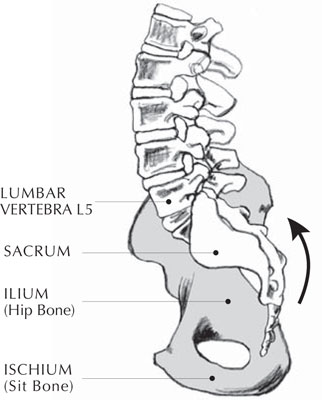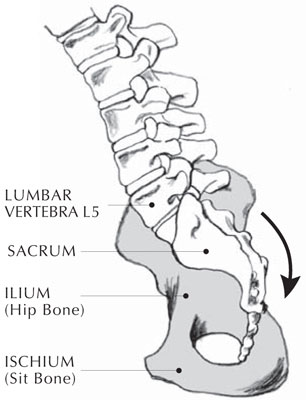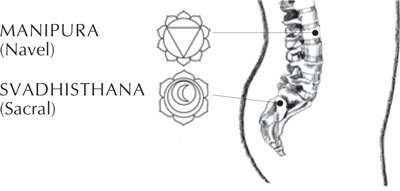Yoga for a Healthy Lower Back (16 page)
Read Yoga for a Healthy Lower Back Online
Authors: Liz Owen

When you look at an image of a sacral bone from the front or back, it actually resembles a heart-shaped wedge that slides neatly between the two winglike hip bones that surround it (
illustration 8
). But when you look at it from the side, you begin to understand the sacrum's complexity. The top of the sacral bone moves in toward your navel and forms a concave curve as it connects with the lumbar spine. As it runs down along the hip bones, the sacral bone curves toward your back, creating room in the pelvis for the lower abdominal organs, including your reproductive organs and bladder. At the bottom of the sacrum lies the tailbone, which turns inward, toward your center, at its tip. If you trace your finger along the profile of a sacral bone, you see that it is shaped like a scoop, which is a helpful metaphor for why so many of us suffer from sacral pain when we experience stressâthe “scoop” of the sacrum symbolically gathers and holds energy in your body.
Your sacral bone is hardly smooth and tidy. It's actually bumpy and curved where the remnants of the once-separate lower sacral vertebra still protrude. It has hollows and crags along its surface and where it meets your hip bones, and it has openings, called “sacral foramina,” from which nerve roots emerge and travel down into your lower body.
Both the front and back surfaces of the sacral bone are covered by webs of crisscrossed ligaments that resemble something that came out of Spider-Man's wrists. These ligaments are designed to stabilize and hold your sacral joints together. They consist of thousands of fibers bundled together, connecting the sacral bone to the hip bones. The ligaments are not as fluid and stretchable as musclesâthey are fibrous and strong in order to hold the joints securely together. But if your sacral joints feel tight, don't despairâthese ligaments do have a little movement and give, enough to support everyday movements, including walking, sitting, bending forward and backward, and twisting. When the ligaments are in balance, those movements can be fluid and smooth.
The bottom of the sacral bone is connected to the top of the thigh bones by the piriformis muscles. If the piriformis is tight, it can tug on one side of the sacral bone or the other, creating imbalances in sacral alignment. The gluteus maximus muscles, which are the outermost, broad, thick muscles of the buttocks, also have their origin at the back of the lower part of the sacral bone and along the edge of the hip bones. Both the piriformis and the gluteus maximus muscles play major roles in sacral and hip mobility.
Your two psoas major and iliacus muscles, which run like channels of muscular support deep in the center of your body from the base of the thoracic spine to the thigh bones, broaden and widen at the sacrum like a river flowing around a spit of land. Tight psoas muscles often cause tightness and forward pull in the lumbar spine and the top of the sacrum, as well as weakness in the muscles of the back hips and abdominals.

Illustration 9. The Sacrum in Nutation

Illustration 10. The Sacrum in Counternutation
In addition to getting pulled and shifted by imbalances in the bones, musculature, and myofascia around the sacrum, the sacral bone itself can tip forward and backward in relation to the hip bones.
2
These movements are called
nutation
and
counternutation.
If these sound like painful conditions, don't worryâthey're normal within a balanced and toned lower back. But they are important to understand so you can work with themâand not overdo themâas you create healthy movements in your sacrum and lower back.
Nutation is your sacrum's way of helping your spine in its journey into a backbend. In nutation, the top of your sacral bone tips forward toward your front body relative to your hip bones (
illustration 9
). I think of it as your sacrum “nodding” to the flow of energy and inner power within your pelvis, similar to how I bow my head toward my heart at the beginning of a yoga practice so that my practice comes from the energy of my heart. Nutation is the natural, passive movement of your sacrum that accompanies extension (back bending) in your lower back, during which your lumbar spine also moves forward toward your front body. Your middle and upper spines follow suit, arching toward your front body as you bend backward. The result of a backbend rooted in a sacrum in nutation is evenness through your
entire spine, with each vertebra equally involved. This kind of backbend both helps maintain comfort in and brings strength to your lower back's most vulnerable part. You'll review nutation and learn how to come into a healthy backbend as you practice variations of
Cobra
and
Locust Poses
.
Counternutation is how your sacrum helps your spine in its journey into a forward bend. This is the natural tilting movement of your sacral bone slightly backward in relation to your hip bones (
illustration 10
). Not surprisingly, it is the opposite of how your sacral bone moves in a backbend. When your sacral bone comes into counternutation, the lumbar spine elongates and rounds slightly, and the process of bending forward is eased along the length of your spine. But just as too much nutation can cause compression in the lower back in back bending, too much counternutation can cause your sacral joints to become destabilized in forward bending. If the sacral ligaments are weak or too flexible, the sacral bone can shift out of alignment and cause great pain. You'll review counternutation and learn how to come into a healthy forward bend later in the chapter before you practice
Half Forward Bend Pose
and
Standing Forward Bend Pose
.
Are you starting to get a picture of all that goes on around the sacrum? It's a busy place! When the sacral joints, hip bones, and spine are balanced and aligned, the area is a symphony of movement as smooth and graceful as Beethoven's Pastoral. When the body becomes imbalanced, though, through repetitive movements, injuries, structural imbalances, or general everyday stress and tension, the sacral joints can turn into a cacophony of misalignment, torsion, and tilting. These imbalances create strain and can cause discomfort across the horizontal area of the upper back hips (called the sacral band), along the sacral joints, down into the legs, and sometimes even radiating around to the front of the thigh.
Physically speaking, the goal in working with the sacrum in yoga is to facilitate its return to its naturally centered and balanced alignment in relation to the spine and hips after any movement, and to create space at the sacral joints and where the sacral spine meets the lumbar spine. This is achieved by toning the deep hip muscles, the abdominal core, and the lower back muscles. Together, these actions work to hold the hips and sacral joints in alignment.
The poses and meditations in this chapter will help you do just that; you
will learn about your own sacrum, where there is comfort and discomfort in and around it, and how to help your sacral joints come back to their centered and balanced alignment in your body.
T
HROUGH
E
ASTERN
E
YES: THE
E
NERGETIC
V
IEW
Chakras: The Luminous Energy Centers of Your Sacrum
I've talked about the amazing physical architecture of the sacrum. Now it's time to contemplate how the sacrum is also stunningly designed from an energetic point of view.
When you take a walk in a place that feels special to you, no doubt you perceive a particular quality that connects you to your inner feelings. Maybe it's the way the sun's rays float between two stands of trees and illuminate the path; maybe it's a point where soft breezes flow in different directions and surround you with nature's breath. The sacrum is this kind of special place within your body. It's a place, some yogic traditions teach, in which many different kinds of energy flow, converge, and spread out. Simply put, a healthy sacral chakra opens and illuminates the path to your inner Self.
In chapter 2, I talked about the first and second chakras, Muladhara and Svadhisthana, which are located, respectively, at the base of your hips and the lower pelvic area. Perhaps you remember that Muladhara is the earthy root chakra and Svadhisthana is the sacral chakra, which is the symbolic home of water in your body and the dwelling place of the Self. The Svadhisthana chakra is the place where fluidity and creativity reside; it's where seeds of personal growth become manifest, and one of its translations is “self-reliance.” In yogic mythology, the deity Vishnu, who represents the energy of preservation within the body (and the entire universe, for that matter) resides in this chakra. He is often depicted holding a conch shell that contains the sound of ocean waves, which he offers to us as a symbol of liberation for all beings. The Svadhisthana chakra is also said to be the home of dharma,
3
which can be translated as one's nature and characteristics, or one's duty. So when the energy of your sacral chakra is balanced and flowing, you are free to become attuned to the creative energy within you that helps you find a fulfilling path in life.
The top of the sacrum is a transitional area between the fluid nature of
Svadhisthana and the heated, fiery nature of the third chakra, called the Manipura chakra. The Manipura chakra is the center of personal power and vitality in the energetic bodyâit is the home of heat and fire that fuels the flow of prana, or life force (
illustration 11
). I'll get more into the Manipura chakra in chapter 4. But it's worth noting here because its activation point is right behind the navel, and that's very often aligned with the top of your sacrum. So the energy of the Manipura chakra has an effect on the sacrum.
The word
Manipura
means “city of gems.” When it is open and balanced, your Manipura chakra is a place of luminosity and energy that fuels lifeâit's your personal sun, contained but powerful, and it illuminates your path toward self-activation. When it's out of balance, energetically speaking, there's too much heat and fire in your body. In this holistic view, “burning” or “hot” pain in your sacrum may be your body's way of letting you know that your Manipura chakra needs some attention.
There are many reasons the Manipura chakra may be out of balance. Muscular tightness in the deep hip muscles and the lower back due to injury, musculoskeletal imbalances, or unhealthy posture may restrict its energy. Stressors in everyday life and pressures in the workplace (and the accompanying poor sitting and standing postures those things usually bring) can turn into gripping and stiffening in the sacrum.
Yet we all know that sometimes the causes of imbalances in the body are next to impossible to figure out! Luckily for us, though, the energy of the Manipura chakra flows down into the Svadhisthana chakra. Energetically speaking, the watery nature of Svadhisthana balances the fire of Manipura, and the result is a practical energy that helps to transform your ideas of self-fulfillment into reality. Next time you get a “gut feeling,” imagine this balancing action between your two chakras, and visualize your sacrum as the vessel that holds them in balanced relationship with each other.

